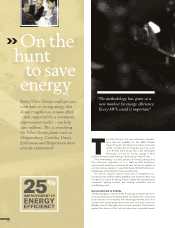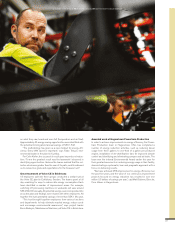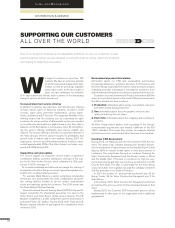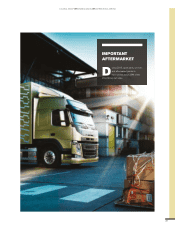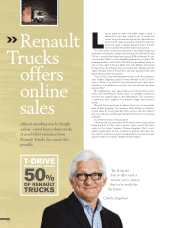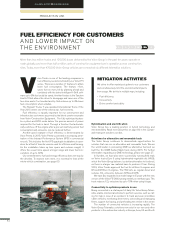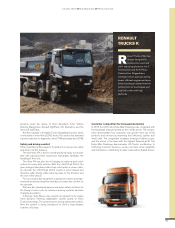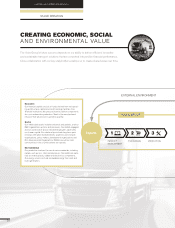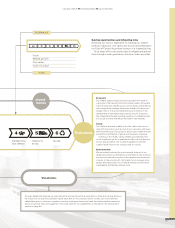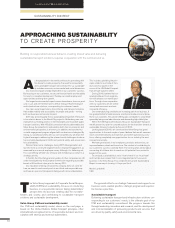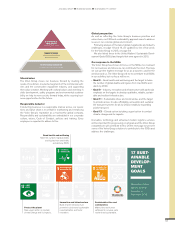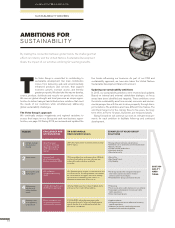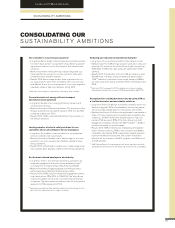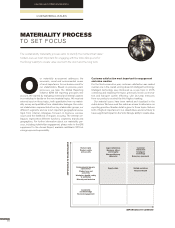Volvo 2015 Annual Report Download - page 48
Download and view the complete annual report
Please find page 48 of the 2015 Volvo annual report below. You can navigate through the pages in the report by either clicking on the pages listed below, or by using the keyword search tool below to find specific information within the annual report.
The Volvo Group works consistently with lean meth-
odologies to use less material as well as pro-
cesses to integrate more recycled materials,
reduce waste and energy, recover heat, and
assess our water footprint.
We offer refurbished spare parts as a way of
extending the useful life of our products, and to reduce costs for
our customers. Remanufacturing consists of three different parts:
1. Collecting: the customer’s worn part is collected and
replaced with an exchange part – this part can be new or
remanufactured.
2. Repairing: once the core is deemed reusable, it will be dis-
assembled, cleaned, re-machined, reassembled and tested.
3. Replacing: a new customer buys the remanufactured part
from the dealer.
Growing remanufacturing business
Remanufacturing engines, gear boxes and other spare parts is a
growing trend and a growing part of the Volvo Group’s business.
In 2015, total Volvo Group sales of remanufactured components
amounted to SEK 8.3 billion, an increase of close to 20% com-
pared with 2014.
The Volvo Group has more than 50 years of experience and
eight remanufacturing centers worldwide handling used compo-
nents from our whole range of products. The first center opened
in 1960 in Flen, Sweden. Other centers are located in France,
Japan, Brazil, US and China. In 2015 a new center in Bangalore,
India, was inaugurated. The center will play an important role in
the aftermarket offer for Volvo branded trucks, buses and con-
struction equipment in the Indian market.
Remanufacturing is also contributing from a societal perspec-
tive as it is more labor intensive than new production and demands
high-skilled employees.
Remanufactured components are offered to Volvo Group cus-
tomers worldwide. Through exchange, engines, gearboxes, exhaust
filters and rear axle transmissions can be renovated to the same
condition as new parts, and our range continues to increase. Cus-
tomers benefit from the same quality and a full warranty, delivered
at a lower price.
Environmentally, remanufacturing minimizes the need for raw
materials. It also significantly reduces energy consumption and
emissions. For example, a remanufactured engine saves up to
80% of the energy needed to build a new engine and dramatically
cuts the emissions of nitrogen oxides and carbon dioxide. It also
ensures that potentially dangerous residuals inside worn compo-
nents are dealt with correctly.
TAKING A CIRCULAR
APPROACH
Improved resource efficiency, reuse and recycling are increasingly important for society and our
industry tocounteract increasing demands and costs on the use of the planet’s finite natural capital.
Circular product development
A truck produced by the Volvo Group is largely recyclable, since
almost 85% of its weight consists of metal – mostly iron, steel and
aluminum. The additional materials are mainly plastic, rubber and
material from electronics components.
In order to work efficiently, recycling and remanufacturing
activities have to be considered during the product planning
phase. The Volvo Group’s experts within this area, therefore works
closely together with product developers to enable disassembly
workers to extract the most material, and value, from our vehicles
at the end of their life.
Triple win
In the last couple of years Volvo Group North America have
marketed remanufactured components for the aftermarket. It is
called the “The Triple Win” because:
• Customers can buy a high quality part for a significantly lower price
• Volvo Group can increase sales
• The reduced number of new components and quality-assured
reused components deliver environmental benefits.
The project focuses on powertrain components and contains a
mix of remanufactured components from suppliers and from
Volvo operations internally.
In 2015, total Volvo Group sales
of remanufactured components
increased by close to 20% compared
with 2014.
A GLOBAL GROUP BUSINESS MODEL
REUSE & RECYCLING
46


